Plant Overview
Mahonia is also popularly recognized as the name of the Oregon grape, which points to its North American origins. The small blueish fruits or grapes of this plant follow a display of fragrant, golden yellow flowers that adds vibrant beauty to your garden.

These winter-blooming yellow flowers provide an invaluable source of pollen and nectar to the winter-active bees and other pollinators when there’s a chance of little else in flower.
Along with the evergreen spiny foliage, these yellow flowers plant look fantastic underplanted with contrasting foliage plants that also can thrive in shade, just like elephant’s ears, fringe cups, and epimedium.
Varieties of mahonia
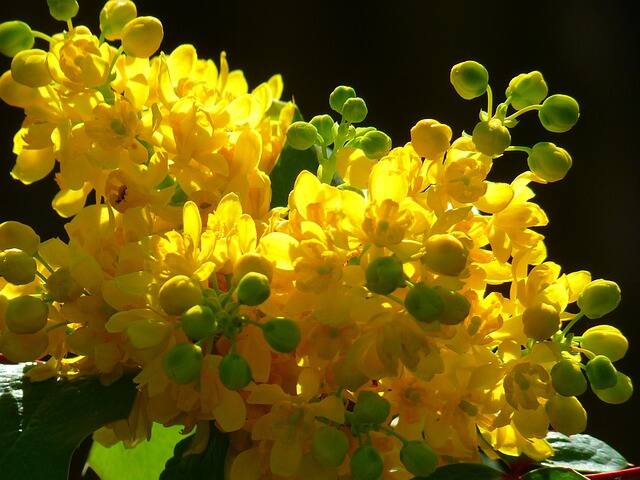
There are a lot of varieties of mahonia available in the world. However, some of the popular varieties are given below.
Mahonia x media
Mahonia X media is one of the popular varieties of mahonia that showcases typical bright yellow, fragrant flowers from late autumn to late winter. This variety looks good at the back of the borders.
Mahonia aquifolium ‘Apollo’
Mahonia aquifolium apollo is one of the compact cultivars of the mahonia, that grows in a neat spreading dome. Along with the glossy, dark green leaves, this variety flushes purple in winter with the characteristic yellow flowers that appear in early spring, followed by blue-black berries.
Mahonia repens
Mahonia repens is a creeping Oregon grape variety with a low-growing habit, that makes it a great groundcover in shady areas. The attractive foliage of this variety turns purplish in winter and showcases bright yellow, fragrant flowers appearing in spring.
Mahonia x media ‘Charity’
Mahonia x media ‘Charity’ is a renowned variety with an upright growing habit and long leaves. This variety showcases stalks of bright yellow, fragrant flowers that are produced at the ends of branches from late autumn to late winter.
Mahonia x media ‘Underway’
Mahonia x media underway is a compact mahonia with an upright growing habit. The bright yellow, fragrant flowers of this variety are generally produced in late autumn, earlier than other mahonias, followed by blue-black berries
Mahonia eurybracteata ‘Soft Caress’
It is a new variety introduced to the family with finely divided soft evergreen, bamboo-like foliage. This variety looks completely different from the other varieties and its yellow flowers of it appear in late summer and autumn.
How to plant Mahonia?
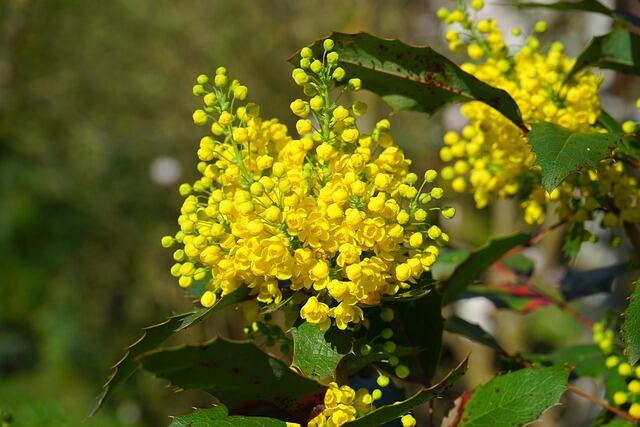
It is suggested to plant a Mahonia from spring or autumn when the climate is neither too hot nor too cold. Before planting your plant, you should first soak the root ball in water for at least half an hour, to ensure it is moist. You can add small blood, fish, and bone meal upon planting, to encourage new root growth.
To plant your Mahonia, you should first dig a hole twice the size of the root ball. While planting, you will also need to make sure that your plant has enough space around it to grow, as they are unable to grow well in crowded conditions. Exactly how much size is required for your plants depends on the variety and the size of its ultimate spread.
Place your root ball in the hole that you dug, fill it in with compost, and feed it with blood, fish, and bone meal. It is recommended to avoid high nitrogen plant foods. Water your plant frequently while growing.
However, it is suggested not to allow the ground to become waterlogged. Once your plant is established, it will require very little watering. So you may only need to water it during extremely hot, and dry periods.
How to care for Mahonia?
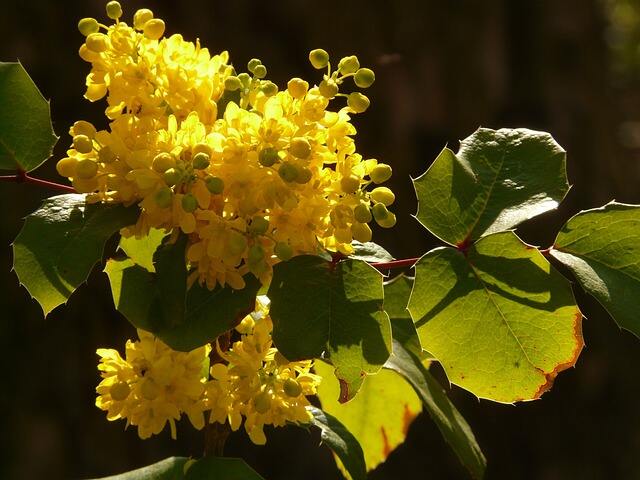
Mahonias are very popular to be slow-growing, hardy, and low-maintenance shrubs. This plant doesn’t like to be moved. so appropriate site selection is very essential for their successful growth.
Your shrub requires to be protected from freezing winds as these can cause burns in the winter. Apart from that, make sure your plant is getting enough space to grow as they aren’t fans of being crowded.
Light
Most of the mahonia can tolerate full sun and heavy shade, however, they thrive well in partial shade positions. Deep shade can result in leggy growth for this plant.
Soil
One of the biggest advantages of growing mahonia species is that they don’t tend to be very particular about the type of soil they grow in. they can grow in any type of soil.
They do well in sandy, loamy, and clay types of soil and across a range of pH levels. The only requirement by the plant is that the soil just needs to be moist and well-drained.
Water
Usually, this plant do their best with regular deep watering while they’re establishing especially during the first year. Although it is suggested to avoid waterlogging.
Mahonia is known for being pretty drought tolerant and once established it will only require watering when there are hot, dry spells.
Temperature and Humidity
Mahonias are only suspected of freezing winds, otherwise they usually can tolerate a wide range of temperatures.
They’re typically able to tolerate temperatures as low as 5 degrees Fahrenheit. If temperatures drop as lower than this, mulching in the fall around the shrub can protect the roots from burning.
Fertilizer
This plant doesn’t require a rigorous regime of fertilization. An annual spring feeding along with a slow-release, low-nitrogen fertilizer and a rich layer of mulch or compost with fish and bone meal should be sufficient for its better growth of it.
How to prune Mahonia?
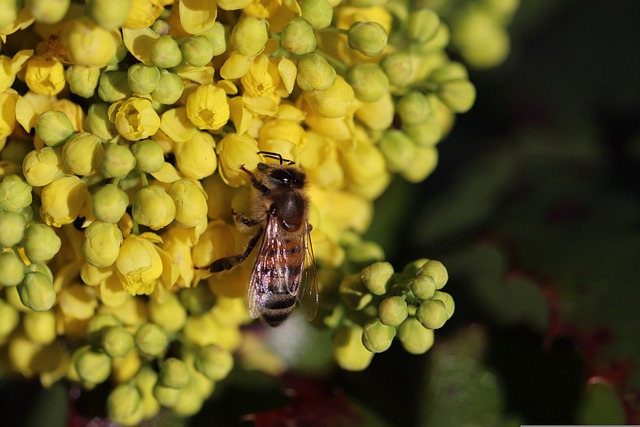
Mahonia is very easy to take care of and it requires little or no pruning. However, it will not be harmed by pruning. Providing pruning allows it to reach its full height first. If pruning is necessary the best time to do it is in spring, basically in April or May, after the last frosts have passed.
You can take the opportunity of passed frost to reshape your plant, by deadheading and removing any damaged or diseased shoots, and thinning out any crowded-looking branches. As a general rule, you should aim to remove around one-third of the total old wood. It is necessary to mulch and feed your plant after pruning, to encourage new growth.
If you are willing to propagate your plant in that season, you should prune it harder in the spring making sure that you have plenty of healthy new growth from which to take cuttings.
Another time you may also need to prune your plant is when it becomes ‘leggy’ which means bare and woody at the base. In this meantime, prune away a significant portion of the lower branches of your plant, to allow more light to penetrate, and stimulate new growth. You can also go for annual pruning to avoid your shrub to become leggy.
How to propagate Mahonia?
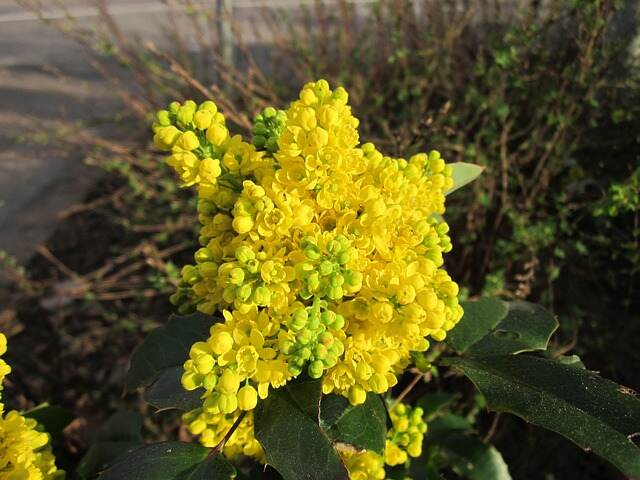
If you want to have another new plant, the best way to acquire plants is through propagation. The best time for propagation is usually from late summer to early autumn, prior to flowering.
You can also propagate your plant easily by taking semi-ripe cuttings from the plant. As we discussed earlier, prepare your plant for propagation by pruning hard in spring, to ensure plenty of new growth.
When it comes to taking your cuttings, you should choose healthy, horizontal shoots from the current season, which have short gaps between the leaves.
Use any sharp secateurs to make a cutting of approximately 15cm, just below the leaf node. Propagate your plant in the morning, so that you can prevent wilting.
Once you’ve taken the cutting, store it in a cool place, and aim to plant it within 12 hours. Dip the base of your cutting in some rooting hormone powder to encourage growth, and plant the cutting in pots filled with a mix of potting compost and sharp sand.
Place it in a greenhouse condition or cover it with plastic indoors to keep your cutting warm. Keep your soil moist, but well-drained. Remove any dead material regularly, to prevent mold.
Conclusion
Mahonias are the evergreen plants with shiny dark green pinnate foliage and spines only on the leaf edges.
As you read the article this far, you might have been aware of the growing and caring guide of the this plant.
Then what are you waiting for?
Bring a beautiful mahonia plant to your home and gardens and add some greenery and beauty to it.
You may also like to read
How to grow and care for lilacs?- A step-by-step guide
How to grow and care for bottlebrush plant – A detailed guide






